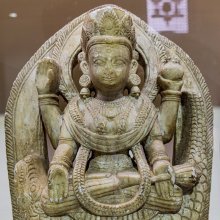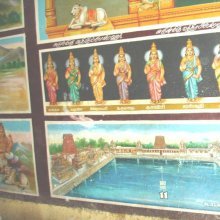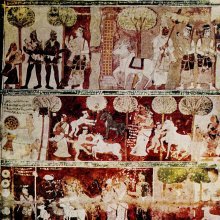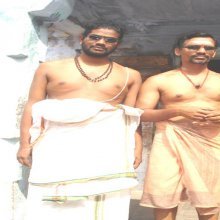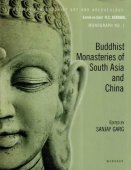Yamuna, Yamunā, Yāmuna, Yāmunā, Yamuṉā: 44 definitions
Introduction:
Yamuna means something in Buddhism, Pali, Hinduism, Sanskrit, Jainism, Prakrit, the history of ancient India, Marathi, Hindi, Tamil. If you want to know the exact meaning, history, etymology or English translation of this term then check out the descriptions on this page. Add your comment or reference to a book if you want to contribute to this summary article.
Images (photo gallery)
In Hinduism
Natyashastra (theatrics and dramaturgy)
Source: archive.org: The mirror of gesture (abhinaya-darpana)One of the Hands of the Famous Rivers.—Yamunā, the Rekhā hand. Also see: Vyāvṛttacāpaveṣṭitau.

Natyashastra (नाट्यशास्त्र, nāṭyaśāstra) refers to both the ancient Indian tradition (shastra) of performing arts, (natya—theatrics, drama, dance, music), as well as the name of a Sanskrit work dealing with these subjects. It also teaches the rules for composing Dramatic plays (nataka), construction and performance of Theater, and Poetic works (kavya).
Vaishnavism (Vaishava dharma)
Source: ISKCON: Śrī StavamālāMay Śrī Yamunā, who is the daughter of Sūryadeva, who saves one from having to enter the city of her brother Yamarāja, the sight of whom enables the most sinful persons to cross the ocean of sin, and the sweetness of whose water charms the hearts of everyone, always purify me.
May Śrī Yamunā, who is the daughter of Sūryadeva, who decorates the great Khāṇḍava forest with a stream of pleasant waters, who is filled with lotus flowers and dancing birds, and who blinds the terrible sins of they who desire to bathe in her, always purify me.
May Śrī Yamunā, who is the daughter of Sūryadeva, who is filled with the warblings of thousands of joyful mallikākṣa swans, who is worshiped by the Vaiṣṇavas, devas, siddhas, and kinnaras, and the slightest scent of the fragrant breeze moving on whose shores stops the cycle of repeated birth and death, always purify me.
May Śrī Yamunā, who is the daughter of Sūryadeva, who is the famous, splendid, spiritual river flowing through the Bhuḥ, Bhuvaḥ, and Svaḥ planets, who burns away the greatest sins, and who is fragrant with scented ointments from Lord Kṛṣṇa's transcendental body, always purify me.
Source: Pure Bhakti: Brhad BhagavatamrtamYamunā (यमुना) refers to:—A sacred river flowing through the land of Vraja. She is considered the holiest of rivers because Kṛṣṇa performed many sublime pastimes in her waters with the gopīs and gopas. In this world, she appears at Yamunottarī in the Himālayas. Yamunā is described as an expansion of Viśākhā Devī. (cf. Glossary page from Śrī Bṛhad-bhāgavatāmṛta).
Source: Brill: Śaivism and the Tantric Traditions (vaishnavism)Yāmuna (यामुन) or Āḷavantār refers to one of the Teachers mentioned in the guruparaṃparā of Vedānta Deśika’s Yatirājasaptati.—The poem’s first ten verses create the context for the exaltation of Rāmānuja. This context is the lineage of teachers (guruparaṃparā) who preceded him and are listed in the first eight verses of the poem in the following order: Nārāyaṇa, Śrī-Lakṣmī, Viṣvaksena, Nammāḻvār, Puṇḍarīkākṣa (Uyyaṅkoṇṭār), Śrīrāmamiśra (Maṇakkāl Nampi), Yāmuna (Āḷavantār) and Mahāpūrṇa (Periya Nampi). In verse 11 Rāmānuja is addressed, for the first time, with the phrase “Lord of the Ascetics” (patiṃ yatīnām).

Vaishnava (वैष्णव, vaiṣṇava) or vaishnavism (vaiṣṇavism) represents a tradition of Hinduism worshipping Vishnu as the supreme Lord. Similar to the Shaktism and Shaivism traditions, Vaishnavism also developed as an individual movement, famous for its exposition of the dashavatara (‘ten avatars of Vishnu’).
Purana and Itihasa (epic history)
Source: Wisdom Library: Varāha-purāṇaYamunā (यमुना).—Name of a river originating from Himālaya, a holy mountain (kulaparvata) in Bhārata, according to the Varāhapurāṇa chapter 85. There are settlements (janapada) where Āryas and Mlecchas dwell who drink water from these rivers.
Bhārata is a region south of Hemādri, once ruled over by Bharata (son of Ṛṣabha), whose ancestral lineage can be traced back to Svāyambhuva Manu, who was created by Brahmā, who was in turn created by Nārāyaṇa, the unknowable all-pervasive primordial being.
Source: archive.org: Puranic Encyclopedia1) Yamunā (यमुना).—Another name for the river Kālindī. (See also under Kālindī). How the water in Kālindī turned Black:-The water in the river Kālindi is black in colour. There is a story behind the changing of the colour of this river-water into black. Originally it was clear. (See full article at Story of Yamunā from the Puranic encyclopaedia by Vettam Mani)
2) Yāmuna (यामुन).—A town in ancient India. (Mahābhārata, Bhīṣma Parva, Chapter 9, Verse 51).
3) Yāmuna (यामुन).—A mountain, made famous in the Purāṇas, standing between the rivers Gāṅgā and Yamunā. (Mahābhārata Anuśāsana Parva, Chapter 68, Verse 3).
Source: archive.org: Shiva Purana - English TranslationYamunā (यमुना) is the name of a sacred river as mentioned in the Śivapurāṇa 1.12, “somehow men must strive to find a residence in a holy centre. On the shores of the ocean in the confluence of hundreds of rivers there are many such holy centres (puṇyakṣetra or tīrtha) and temples. [...] The devotees of Śiva are the bestowers of Śivaloka and accord cherished desires. [...] When Jupiter and the sun are in the zodiac of Kanya, ablution shall be performed in the rivers—Yamunā and Śoṇa, the fruit of which is great enjoyment in the worlds of Dharma and Dantin (Gaṇeśa)”.
Source: Cologne Digital Sanskrit Dictionaries: The Purana Index1a) Yamunā (यमुना).—(kālindī) (R.) in Bhāratavarṣa from the Himālayas; a divine stream.1 A mahānadī.2 Here Vidura met Uddhava;3 the co-wives who administered poison to Citraketu's son, had a purificatory bath in; Citraketu, who was initiated into the vidyā by Nārada had his preliminary bath in this river.4 On its banks Vaivasvata Manu performed tapas for progeny, and Bharata celebrated his horse sacrifice. On its banks stands Madhuvana near Bṛṇdāvana. Kṛṣṇa, his brother, and others played there and once defeated the Asura Vatsa. Gopi girls bathed there as part of the kātyayanī vrata. Nanda used to bathe here.5 Immersed in its waters Saubhari performed penance. Poisoned by the Kālīya; Kṛṣṇa sent away the reptile to the sea and made its waters drinkable; unapproachable to Garuḍa by a curse of Saubhari.6 Akrūra who took Kṛṣṇa and Rāma to Mathurā, had his bath on the way in this river. Inside the waters he saw both Kṛṣṇa and Rāma; also saw Hari on the Śeṣa. Here Kṛṣṇa killed Haṃsa.7 On its bank Jarāsandha encamped to besiege Mathurā. Here Kṛṣṇa had his avabhṛta after the horse sacrifice. Here again Kṛṣṇa and Arjuṇa met Kālindī.8 During his pilgrimage Balarāma visited this.9 Was in floods when Vasudeva crossed it for Gokula with the new born babe, Kṛṣṇa.10 Sacred for śrāddha; sometimes too hot and sometimes too cold; daughter of Mārtāṇḍa and Samjñā and sister of Yama; got changed into a sacred river. On its northern bank is Prayāgā (Pratiṣṭhāna).11 Sacred to Mṛgāvatī; sacred to the Pitṛs;12 a boundary of the kingdom of Pitṛs;13 in the chariot of Tripurāri;14 one of the 16 wives of Havyavāhana (fire)15 forms the left side of the Veda;16 daughter of Sureṇu and Sūrya;17 a sacred river.18
- 1) Bhāgavata-purāṇa V. 19. 18; Vāyu-purāṇa 45. 95.
- 2) Ib. 104. 50.
- 3) Bhāgavata-purāṇa III. 1. 24; 2. 27; IV. 2. 35.
- 4) Ib. VI. 16. 14 and 16.
- 5) Ib. IX, 2. 1; 4. 30; 20. 25; X. 11. 36-43; 22. 2, 6, 36; 28. 1.
- 6) Ib. IX. 6. 39; X. 15. 47-8; 16. 4, 60-7; 17. 8-11.
- 7) Ib. X. 39. 38-46; 76. 2 [8]; 78. [1).
- 8) Ib. X. [50 (v) 6 and 14]; 89. 63 [4]; 58. 16-7.
- 9) Ib. X. 78. 20.
- 10) Ib. X. 3. 50.
- 11) Brahmāṇḍa-purāṇa II. 16. 25; III. 13. 71-2; 59. 23 and 83; 66. 21; 73. 117; IV. 15. 23; Matsya-purāṇa 11. 4, 39; 104. 19; 108. 22; Vāyu-purāṇa 77. 69-70.
- 12) Matsya-purāṇa 13. 40.
- 13) Ib. 22. 20.
- 14) Ib. 110. 5; 114. 21; 133. 23; 163. 61; 239. 18.
- 15) Ib. 51. 13; Vāyu-purāṇa 29. 13.
- 16) Ib. 104. 77; 108. 79.
- 17) Ib. 58. 88; 84. 22.
- 18) Brahmāṇḍa-purāṇa II. 12. 14; Vāyu-purāṇa 98. 117; Viṣṇu-purāṇa III. 14. 18; V. 3. 18; 7. 7ff; 18. 33.
1b) (personified) sister of Yama. Once Balarāma invited her for watersports, and got enraged at her delay. Hence he dragged her by means of his plough through Bṛṇdāvan. This changed her course; then she prayed for mercy which was granted. She presented Rāma with clothes and jewels. Even now the change in the course is noticeable.*
- * Bhāgavata-purāṇa X. 3. 50; Ib. ch. 65 (whole); Viṣṇu-purāṇa V. 25. 8-11, VI. 8. 31.
2) Yāmuna (यामुन).—A tribe.*
- * Bhāgavata-purāṇa I. 10. 34.
3) Yāmunā (यामुना).—On its north bank was situated Pratiṣṭhāna*
- * Vāyu-purāṇa 91. 50.
Yāmuna (यामुन) is a name mentioned in the Mahābhārata (cf. V.19.30, VIII.30.10) and represents one of the many proper names used for people and places. Note: The Mahābhārata (mentioning Yāmuna) is a Sanskrit epic poem consisting of 100,000 ślokas (metrical verses) and is over 2000 years old.
Yamunā also refers to the name of a River mentioned in the Mahābhārata (cf. I.63.47, I.63, III.88.2, VI.10.14).
Source: Shodhganga: The saurapurana - a critical studyYamunā (यमुना) is the daughter of Rājñī and Bhāskara (sun-god): the son of Aditi and Kaśyapa according to the Vaṃśānucarita section of the 10th century Saurapurāṇa: one of the various Upapurāṇas depicting Śaivism.—Accordingly, the Saurapurāṇa 30.27-73 and chapter 31 descibes the vaṃśānucarita in an abridged form. It is stated that Aditi got from Kaśyapa, Bhāskara, the Sun-god. The Sun-god had four wives—Saṃjñā, Rājñī, Prabhā and Chāyā. Saṃjñā gave birth to Manu from the Sun-god in whose race were born the kings. Rājñī gave birth to Yama, Yamunā and Revanta.

The Purana (पुराण, purāṇas) refers to Sanskrit literature preserving ancient India’s vast cultural history, including historical legends, religious ceremonies, various arts and sciences. The eighteen mahapuranas total over 400,000 shlokas (metrical couplets) and date to at least several centuries BCE.
Kavya (poetry)
Source: Wisdom Library: KathāsaritsāgaraYamunā (यमुना) is the daughter of the hermit (Ṛṣi) Mātaṅga, according to the Kathāsaritsāgara, chapter 67. Accordingly as Mātaṅga’s daughter said to Candrasāra: “... and immediately I beheld the daughter of the hermit Mātaṅga, who appeared unexpectedly. She [Yamunā] was in brightness like the sun, subject to a vow of chastity from her earliest youth, with body emaciated by penance.”.
The Kathāsaritsāgara (‘ocean of streams of story’), mentioning Yamunā, is a famous Sanskrit epic story revolving around prince Naravāhanadatta and his quest to become the emperor of the vidyādharas (celestial beings). The work is said to have been an adaptation of Guṇāḍhya’s Bṛhatkathā consisting of 100,000 verses, which in turn is part of a larger work containing 700,000 verses.
Source: Shodhganga: A critical appreciation of soddhalas udayasundarikathaYamunā (यमुना).—One of the four rivers if India mentioned by Soḍḍhala.—Yamunā takes its rise from Kalindagiri, a portion of the Bandarapuccha mountain, whence it is called Kalindakanyā. It falls into the Ganges at Allahabad and a bath at the confluence is considered very meritorious. The waters of the river had been purified by the contact of the body of Kṛṣṇa, who used to have water sports along with the multitude of Gopīs in love. It throws off foams on its bank as it were the worn and torn pieces of the slough of Kalīyabhujaṅgama. Mathurā is situated on the bank of the river Yamunā.
Source: Shodhganga: The Kavyamimamsa of RajasekharaYamunā (यमुना) is the name a locality mentioned in Rājaśekhara’s 10th-century Kāvyamīmāṃsā.—The River Jumnā.

Kavya (काव्य, kavya) refers to Sanskrit poetry, a popular ancient Indian tradition of literature. There have been many Sanskrit poets over the ages, hailing from ancient India and beyond. This topic includes mahakavya, or ‘epic poetry’ and natya, or ‘dramatic poetry’.
Ayurveda (science of life)
Dietetics and Culinary Art (such as household cooking)
Source: Shodhganga: Dietetics and culinary art in ancient and medieval IndiaYamunā (यमुना) is an important river whose water (jala) qualities are described in the Bhojanakutūhala (dravyaguṇāguṇa-kathana), and is commonly found in literature dealing with the topics of dietetics and culinary art, also known as Pākaśāstra or Pākakalā.—Different types of water (jala) and their properties are mentioned here [viz., in jala-prakaraṇa]. The text explains the qualities of the water of certain important rivers like [viz., Yamunā].

Āyurveda (आयुर्वेद, ayurveda) is a branch of Indian science dealing with medicine, herbalism, taxology, anatomy, surgery, alchemy and related topics. Traditional practice of Āyurveda in ancient India dates back to at least the first millenium BC. Literature is commonly written in Sanskrit using various poetic metres.
Jyotisha (astronomy and astrology)
Source: Wisdom Library: Brihat Samhita by Varahamihira1) Yamunā (यमुना) is the name of a river, according to the Bṛhatsaṃhitā (chapter 5), an encyclopedic Sanskrit work written by Varāhamihira mainly focusing on the science of ancient Indian astronomy astronomy (Jyotiṣa).—Accordingly, “If the sun and moon should begin to be eclipsed when only half risen, deceitful men will suffer as well as sacrificial rites. [...] If they should be eclipsed when in the sign of Gemini (Mithuna), chaste women, princes, powerful petty chiefs, learned men, people living on the banks of the Yamunā [i.e., yamunā-taṭaja] and the rulers of Bahlikā and Matsya with their subjects will suffer miseries. If they should be eclipsed when in the sign of Cancer (Karka) the Ābhīras, the Śabaras, the Pallavas, the Mallas, the Matsyas, the Kurus, the Śakas, the Pāñcālas and the Vikalās will be afflicted with miseries and food grains will be destroyed”.
2) Yāmuna (यामुन) refers to the countries bordering on the Yamunā, belonging to “Madhyadeśa (central division)” classified under the constellations of Kṛttikā, Rohiṇī and Mṛgaśīrṣa, according to the system of Kūrmavibhāga, according to the Bṛhatsaṃhitā (chapter 14).—Accordingly, “The countries of the Earth beginning from the centre of Bhāratavarṣa and going round the east, south-east, south, etc., are divided into 9 divisions corresponding to the 27 lunar asterisms at the rate of 3 for each division and beginning from Kṛttikā. The constellations of Kṛttikā, Rohiṇī and Mṛgaśīrṣa represent the Madhyadeśa or central division consisting of the countries of [i.e., Yāmuna] [...]”.
3) Yāmuna (यामुन) also refers to a country belonging to “Uttaratas or Uttaradeśa (northern division)” classified under the constellations of Śatabhiṣaj, Pūrvabhādrapada and Uttarabhādrapada, according to the system of Kūrmavibhāga.

Jyotisha (ज्योतिष, jyotiṣa or jyotish) refers to ‘astronomy’ or “Vedic astrology” and represents the fifth of the six Vedangas (additional sciences to be studied along with the Vedas). Jyotisha concerns itself with the study and prediction of the movements of celestial bodies, in order to calculate the auspicious time for rituals and ceremonies.
Shilpashastra (iconography)
Source: Shodhganga: Elements of Art and Architecture in the Trtiyakhanda of the Visnudharmottarapurana (shilpa)Yamunā (यमुना) images are associated with Varuṇa, whose iconography is described in the Viṣṇudharmottarapurāṇa, an ancient Sanskrit text which (being encyclopedic in nature) deals with a variety of cultural topics such as arts, architecture, music, grammar and astronomy.—Varuṇa is known as the lord of water. The images of Gaṅgā and Yamunā are also placed in the right and left side of the image of Varuṇa respectively. The image of Gaṅgā should be placed on a crocodile and should hold cāmara i.e., bushy tail of yak. The Viṣṇudharmottarapurāṇa states that the image of Yamunā should be placed on a tortoise and also have cāmara in her hand.

Shilpashastra (शिल्पशास्त्र, śilpaśāstra) represents the ancient Indian science (shastra) of creative arts (shilpa) such as sculpture, iconography and painting. Closely related to Vastushastra (architecture), they often share the same literature.
General definition (in Hinduism)
Source: Wisdom Library: HinduismYamunā (यमुना) is a Sanskrit word referring to a dwelling place or resort of the celestial nymphs (apsaras). They live chiefly on earth around rivers or on mountains, as in the courts of all the gods.
Source: archive.org: Vedic index of Names and SubjectsYamunā (यमुना, ‘twin’) the name of a river, so called as running parallel with the Ganges, is mentioned thrice in the Rigveda, and not rarely later. According to the Rigveda, the Tṛtsus and Sudās won a great victory against their foes on the Yamunā; there is no reason whatever to accept Hopkins’ view that the Yamunā here was another name of the Paruṣṇī (Ravi). In the Atharvaveda the salve (Āñjana) of the Yamunā (Yāmuna) is mentioned along with that of Trikakud (Traikakuda) as of value. In the Aitareya and the Śatapatha-brāhmaṇas the Bharatas are famed as victorious on the Yamunā. Other Brāhmaṇas also mention this river. In the Mantrapāṭha the Sālvas are spoken of as dwelling on its banks.
Source: WikiPedia: HinduismYamuna (जमुना): A river (also spelled Jamuna), joining with the Ganges. Literally meaning "twins" in Sanskrit, as it runs parallel to the Ganges, its name is mentioned at many places in the Rig Veda, written during the Vedic period ca between 1700–1100 BC, and also in the later Atharvaveda, and the Brahmanas including Aitareya Brahmana and Shatapatha Brahmana.
In Buddhism
Theravada (major branch of Buddhism)
Source: Pali Kanon: Pali Proper Names1. Yamuna. The second of the five great rivers of Jambudipa, which are often used in similes. Vin.ii.237; A.iv.101, 198, 202; v.22; S.ii.135; v.401, etc.; Ud.v.5; Mil.114 (where ten rivers are mentioned); Mtu.iii.203, 363.
On its banks were Kosambi and Madhura. For its origin see Ganga. It is stated in the story of Bakkula (ThagA.i.344) that newly born children were bathed in the waters of the Yamuna for their health. The river was evidently the special resort of the Nagas (See, e.g., D.ii.259; J.vi.158, 161ff., 164, 197).
It is said that the fish of the Yamuna considered themselves more beautiful than those of the Ganga. J.ii.151ff. under the river was the realm of the Naga king, Dhatarattha (J.vi.200). The waters of the Ganga mix very easily with those of the Yamuna (J.v.496; vi. 412, 415).
2. Yamuna. A channel branching off westward from the Punnavaddhana Tank. Cv.lxxix.47.
Theravāda is a major branch of Buddhism having the the Pali canon (tipitaka) as their canonical literature, which includes the vinaya-pitaka (monastic rules), the sutta-pitaka (Buddhist sermons) and the abhidhamma-pitaka (philosophy and psychology).
Mahayana (major branch of Buddhism)
Source: Wisdom Library: Maha Prajnaparamita SastraYamunā (यमुना) is the name of a river mentioned by the Buddha while teaching the practice of disgust, as mentioned in the Tiṃsamattā-sutta (or Lohita-sūtra), according to Mahāprajñāpāramitāśāstra chapter XLIII.—Accordingly, “thus forty Bhikṣus from the land of Po-li (“inhabitant of the region of Pāvā”; Pāvā or Pāpā is the actual Kasia) who observed fully the twelve pure practices (dhūtaguṇa) came to the Buddha who taught them the practice of disgust (nirveda, saṃvega). The Buddha asked them: The five rivers, Heng-k’ie (Gaṅgā), Lan-meou-na (Yamunā), Sa-lo-yeou (Sarayū), A-tche-lo-p’o-t’i (Aciravati) and Mo-hi (Mahī) arise and empty into the great ocean (mahāsamudra). Is the mass of water contained in this ocean great or small? The Bhikṣus answered: It is very great. The Buddha continued: In the course of a single kalpa, during his animal existences, a single man has been cut up and flayed. In yet other circumstances when he committed a wrong-doing, his hands and feet have been cut off and his head has been has been cut off. Well then! His blood (lohita) that has been spilled surpasses the amount of water in the ocean”.

Mahayana (महायान, mahāyāna) is a major branch of Buddhism focusing on the path of a Bodhisattva (spiritual aspirants/ enlightened beings). Extant literature is vast and primarely composed in the Sanskrit language. There are many sūtras of which some of the earliest are the various Prajñāpāramitā sūtras.
Tibetan Buddhism (Vajrayana or tantric Buddhism)
Source: 84000: The Basket’s DisplayYamuna (यमुन) refers to one of the great rivers of Jambudvīpa, according to the Kāraṇḍavyūha-sūtra chapter 2 (“”).—Accordingly, as Tathāgata Padmottama praises the qualities of this six-syllable mahāvidyā: “As a comparison, in Jambudvīpa there are great rivers that flow day and night. They are the [e.g., Yamuna] [...]. Each of these rivers has five hundred tributaries. Day and night they flow into the ocean. Noble son, this is how the accumulation of merit increases as the result of a single repetition of the six-syllable mahāvidyā: I can count each drop in those great rivers, but, noble son, I cannot calculate the accumulation of merit that comes from repeating the six-syllable mahāvidyā once”.

Tibetan Buddhism includes schools such as Nyingma, Kadampa, Kagyu and Gelug. Their primary canon of literature is divided in two broad categories: The Kangyur, which consists of Buddha’s words, and the Tengyur, which includes commentaries from various sources. Esotericism and tantra techniques (vajrayāna) are collected indepently.
In Jainism
General definition (in Jainism)
Source: archive.org: TrisastisalakapurusacaritraYamunā (यमुना) is the wife of Samudrasaṅgama from Kundapura, according to the Jain Ramayana and chapter 7.5 [The kidnapping of Sītā] of Hemacandra’s 11th century Triṣaṣṭiśalākāpuruṣacaritra: an ancient Sanskrit epic poem narrating the history and legends of sixty-three illustrious persons in Jainism.—Accordingly, [as some man said to Vajrakarṇa]: “In the city Kundapura there is a merchant, Samudrasaṅgama, a layman; his wife is Yamunā; and I am their son, Vidyudaṅga. In course of time I grew up, and came to Ujjayinī with merchandise to buy and sell. There I saw a doe-eyed courtesan, Kāmalatā, and became at once the abode of the arrows of Kāma. [...]”.

Jainism is an Indian religion of Dharma whose doctrine revolves around harmlessness (ahimsa) towards every living being. The two major branches (Digambara and Svetambara) of Jainism stimulate self-control (or, shramana, ‘self-reliance’) and spiritual development through a path of peace for the soul to progess to the ultimate goal.
India history and geography
Source: archive.org: Geography in Ancient Indian inscriptionsYamunā (यमुना) is the name of a river found in India.—The river Is mentioned also by the name Kālindī in Eran Stone inscription of Budhagupta. The river is identical with modern Jumna or Yamunā, joining the Gaṅgā near Allahabad, the Triveṇī Saṃgama.
Source: archive.org: Personal and geographical names in the Gupta inscriptionsYamunā (यमुना) is the same as the river Kālindī . The Yamunā has got its source from the Kalindadeśa, a mountainous country situated in the Bāndarapuccha range or the Himālaya and hence the river is called Kālindī. In the Purāṇas we get the earlier mention of Kālindī by both the names, Kālindī as well as Yamunā. The Kālindī is also mentioned in the Śiśupālavadha of Māga.
Source: archive.org: Shiva Purana (history)Yamunā (यमुना) is the name of a river and rises in the Himalaya mountains among the Jumnotri peaks, flows for 860 miles on the plains before it joins the Ganges at Allahabad.
Source: archive.org: Ceylon Branch of the Royal Asiatic Society 1963Yamuna is one of the twenty canal-systems associated with Parakkamasamudda waters that existed in the Polonnaruva (Polonnaruwa) district of Ceylon (Sri Lanka).—The Pūjāvaliya gives the name Mahāsamudra to the Parakkamasamudda at Polonnaruva. The canal system associated with Parakkamasamudda is described and named in the Cūlavamsa as follows:—[...] Yamuna canal, which flowed west from Puṇṇavaddhana tank; [...].
Source: Ancient Buddhist Texts: Geography of Early BuddhismYamunā (यमुना) is the name of a river situated in Majjhimadesa (Middle Country) of ancient India, as recorded in the Pāli Buddhist texts (detailing the geography of ancient India as it was known in to Early Buddhism).—Yamunā is one of the five great rivers mentioned in early Pāli literature. It is the modern Jumna.
Source: Shodhganga: A translation of Jhaverchand Meghanis non translated folk talesYamuna refers to “It is one of the pious river of Hindu religions”.—It is defined in the glossary attached to the study dealing with Gujarat Folk tales composed by Gujarati poet Jhaverchand Meghani (1896-1947)

The history of India traces the identification of countries, villages, towns and other regions of India, as well as mythology, zoology, royal dynasties, rulers, tribes, local festivities and traditions and regional languages. Ancient India enjoyed religious freedom and encourages the path of Dharma, a concept common to Buddhism, Hinduism, and Jainism.
Languages of India and abroad
Marathi-English dictionary
Source: DDSA: The Molesworth Marathi and English Dictionaryyamunā (यमुना).—f (S) The Yamuna or Jumna river.
Source: DDSA: The Aryabhusan school dictionary, Marathi-Englishyamunā (यमुना).—f The Jumna river.
Marathi is an Indo-European language having over 70 million native speakers people in (predominantly) Maharashtra India. Marathi, like many other Indo-Aryan languages, evolved from early forms of Prakrit, which itself is a subset of Sanskrit, one of the most ancient languages of the world.
Sanskrit dictionary
Source: DDSA: The practical Sanskrit-English dictionaryYamunā (यमुना).—
1) Name of a celebrated river (regarded as a sister of Yama).
2) Name of Durgā.
--- OR ---
Yāmuna (यामुन).—a. (-nī f.) [यमुना-अण् (yamunā-aṇ)] Belonging to or coming from, or growing in, the Yamunā गाङ्गमम्बु सितमम्बु यामुनं कज्जलाभमुभयत्र मज्जतः (gāṅgamambu sitamambu yāmunaṃ kajjalābhamubhayatra majjataḥ) K. P.1.
-nam A kind of collyrium; यक्षुष्यं यामुनं पुनः (yakṣuṣyaṃ yāmunaṃ punaḥ) Śiva. B.3.18; also यामुनेयम् (yāmuneyam).
Source: Cologne Digital Sanskrit Dictionaries: Shabda-Sagara Sanskrit-English DictionaryYamunā (यमुना).—f.
(-nā) The Yamuna or Jamuna river, which rises on the south side of the Himalaya range, at a short distance to the north-west of the source of the Ganges, and which after a course of about 378 miles falls into that river immediately below Allahabad; in mythology, the personified river is considered as the daughter of Surya, and sister of Yama. E. yam to stop, (at the Ganges,) and unan Unadi aff.
--- OR ---
Yāmuna (यामुन).—mfn.
(-naḥ-nī-naṃ) Relating to the Yamuna river. n.
(-naṃ) Antimony, or rather the sulphuret of antimony, generally used as an application to darken the eyelashes, and strengthen the eyes. E. yamunā the Jamuna river, and aṇ aff.
Source: Cologne Digital Sanskrit Dictionaries: Benfey Sanskrit-English DictionaryYamunā (यमुना).—[yam + unā] (or rather yam + van + a), f. The name of a river,
Yamunā (यमुना).—[feminine] [Name] of river (identif. [with] yamī).
Source: Cologne Digital Sanskrit Dictionaries: Monier-Williams Sanskrit-English Dictionary1) Yamunā (यमुना):—[from yam] f. Name of a river commonly called the Jumnā (in, [Harivaṃśa] and, [Mārkaṇḍeya-purāṇa] identified with Yamī q.v.; it rises in the Himālaya mountains among the Jumnotri peaks at an elevation of 10,849 feet, and flows for 860 miles before it joins the Ganges at Allahabad, its water being there clear as crystal, while that of the Ganges is yellowish; the confluence of the two with the river Sarasvatī, supposed to join them underground, is called tri-veṇī q.v.), [Ṛg-veda] etc. etc.
2) [v.s. ...] of a daughter of the Muni Mataṃga, [Kathāsaritsāgara]
3) [v.s. ...] of a cow, [Kātyāyana-śrauta-sūtra [Scholiast or Commentator]]
4) Yāmuna (यामुन):—mfn. ([from] yamunā) belonging or relating to the river Yamunā (commonly called Jumna), coming from it, growing in it etc., [Mahābhārata; Harivaṃśa; Rāmāyaṇa]
5) m. a [metronymic] [Pāṇini 4-1, 113 [Scholiast or Commentator]]
6) Name of a mountain, [Mahābhārata; Rāmāyaṇa]
7) of an author (also called yāmunācārya and rya-svāmin), [Catalogue(s)]
8) [plural] Name of a people, [Mahābhārata; Varāha-mihira; Purāṇa]
9) n. ([scilicet] āñjana) antimony, collyrium, [Atharva-veda]
10) Name of a Tīrtha, [Mahābhārata]
Source: Cologne Digital Sanskrit Dictionaries: Yates Sanskrit-English Dictionary1) Yamunā (यमुना):—(nā) 1. f. The Jumna river.
2) Yāmuna (यामुन):—[(naḥ-nī-naṃ) a.] Of Yamunā. n. Antimony; a collyrium.
Source: DDSA: Paia-sadda-mahannavo; a comprehensive Prakrit Hindi dictionary (S)Yamuna (यमुन) in the Sanskrit language is related to the Prakrit words: Jauṇa, Jaṃuṇa, Jaṃuṇā.
[Sanskrit to German]
Sanskrit, also spelled संस्कृतम् (saṃskṛtam), is an ancient language of India commonly seen as the grandmother of the Indo-European language family (even English!). Closely allied with Prakrit and Pali, Sanskrit is more exhaustive in both grammar and terms and has the most extensive collection of literature in the world, greatly surpassing its sister-languages Greek and Latin.
Hindi dictionary
Source: DDSA: A practical Hindi-English dictionaryYamunā (यमुना):—(nf) one of the most important Indian rivers (considered to be sacred by the Hindus).
...
Kannada-English dictionary
Source: Alar: Kannada-English corpusYamunā (ಯಮುನಾ):—[noun] = ಯಮುನೆ [yamune].
--- OR ---
Yāmuna (ಯಾಮುನ):—[adjective] of, relating to or getting from the river Yamune.
--- OR ---
Yāmuna (ಯಾಮುನ):—[noun] a silvery-white, brittle, nonmetallic chemical element of crystalline structure, used in collyrium; antimony.
Kannada is a Dravidian language (as opposed to the Indo-European language family) mainly spoken in the southwestern region of India.
See also (Relevant definitions)
Starts with (+14): Yamuna acarya svamin, Yamunabhaj, Yamunabhid, Yamunabhratar, Yamunabhratri, Yamunacanakan, Yamunacariyar, Yamunacarya, Yamunacaryastotra, Yamunacharya, Yamunadatta, Yamunadvipa, Yamunai, Yamunaitturaivan, Yamunajanaka, Yamunaka, Yamunakalyani, Yamunamahatmya, Yamunamuni, Yamunanamani.
Ends with: Divyayamuna, Ganga-Yamuna, Sauyamuna, Suyamuna.
Full-text (+380): Jauna, Kalindi, Mecakapaga, Kalinda, Kalindakanya, Prayaga, Yamunabhratri, Yamunabhid, Antarvedi, Suryaja, Daivakari, Yamabhagini, Yamunajanaka, Dinakaratmaja, Suryatanaya, Tapanatanaya, Dviyamunam, Triveni, Shamanasvasri, Pratishthana.
Relevant text
Search found 140 books and stories containing Yamuna, Yamunā, Yāmuna, Yāmunā, Yamuṉā; (plurals include: Yamunas, Yamunās, Yāmunas, Yāmunās, Yamuṉās). You can also click to the full overview containing English textual excerpts. Below are direct links for the most relevant articles:
Garga Samhita (English) (by Danavir Goswami)
Verse 1.16.47 < [Chapter 16 - Description of Śrī Rādhikā’s Wedding]
Verse 2.2.8 < [Chapter 2 - Description of Girirāja Govardhana’s Birth]
Verse 1.11.49 < [Chapter 11 - Description of Śrī Kṛṣṇacandra’s Birth]
List of Mahabharata people and places (by Laxman Burdak)
Amarakoshodghatana of Kshirasvamin (study) (by A. Yamuna Devi)
Economics (3): Goods of trade < [Chapter 3 - Social Aspects]
Earth and its aspects < [Chapter 5 - Aspects of Nature]
Brihad Bhagavatamrita (commentary) (by Śrī Śrīmad Bhaktivedānta Nārāyana Gosvāmī Mahārāja)
Verse 1.7.50 < [Chapter 7 - Pūrṇa (pinnacle of excellent devotees)]
Verse 1.1.6 < [Chapter 1 - Bhauma (the earthly plane)]
Verse 2.1.90 < [Chapter 1 - Vairāgya (renunciation)]
Bhakti-rasamrta-sindhu (by Śrīla Rūpa Gosvāmī)
Verse 3.5.27 < [Part 5 - Conjugal Love (mādhurya-rasa)]
Verse 2.4.95 < [Part 4 - Transient Ecstatic Disturbances (vyābhicāri-bhāva)]
Verse 3.3.42 < [Part 3 - Fraternal Devotion (sakhya-rasa)]
Cosmetics, Costumes and Ornaments in Ancient India (by Remadevi. O.)
2.2. Pharmaceutical use of Añjana (Collyrium) < [Chapter 1 - Cosmetics]
Related products
